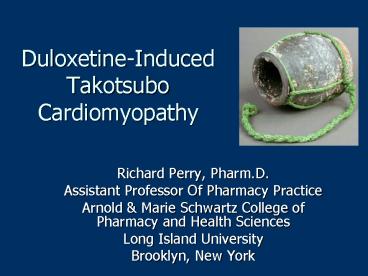Duloxetine-Induced Takotsubo Cardiomyopathy - PowerPoint PPT Presentation
1 / 18
Title:
Duloxetine-Induced Takotsubo Cardiomyopathy
Description:
Assistant Professor Of Pharmacy Practice ... for UTI Time Course of Reaction Presentation at Hospital Developed left sided chest pain Nonradiating, ... – PowerPoint PPT presentation
Number of Views:280
Avg rating:3.0/5.0
Title: Duloxetine-Induced Takotsubo Cardiomyopathy
1
Duloxetine-Induced Takotsubo Cardiomyopathy
- Richard Perry, Pharm.D.
- Assistant Professor Of Pharmacy Practice
- Arnold Marie Schwartz College of Pharmacy and
Health Sciences - Long Island University
- Brooklyn, New York
2
Takotsubo Cardiomyopathy Overview
- Type of stress-induced cardiomyopathy
- Also known as transient left ventricular apical
ballooning, cardiac syndrome X and broken heart
syndrome - Japanese name meaning octopus trap
- Under recognized disease state
- May mimic an acute myocardial infarction (AMI)
- Found in 1-2 of patients with suspected AMI
3
Clinical Presentation
- Most commonly seen in postmenopausal women
- Chest pain
- Dyspnea
- ECG changes
- ST-segment elevation
- QT Prolongation
- ECHO findings
- Left ventricle ballooning of apical and
midventricular segments, hyperkinetic basal
segment - EF Severely decreased
- Laboratory Findings
- CKMB, troponin, catecholamine levels
- Normal coronary arteries or absence of acute
plaque rupture
4
Cardiac Wall Abnormalities
Scott et al. Circulation. 2005 Feb
1111(4)472-9.
5
Pathophysiologic Triggers
- Specific cause is unknown
- Possibly catecholamine mediated
- Epicardial vessel spasm
- Reduction in myocardial oxygen supply
- Commonly preceded by acute emotional or physical
stress - Vigorous excitation
- Acute medical illness
- Acute cocaine intoxication
6
Duloxetine (Cymbalta)
- Serotonin and norepinephrine reuptake inhibitor
(SNRI) - FDA approved for
- Major depressive disorder
- Diabetic peripheral neuropathic pain (DPNP)
- Generalized anxiety disorder
- Initial dose for DPNP 60 mg/daily
- Metabolized through CYP450 1A2 and 2D6
7
Case Report
- 60 y/o HF (Ht, 160 cm Wt, 58.6 kg) admitted to
emergency department - CC Chest pain, lightheadedness, nausea and
diaphoresis - PMH Type 2 diabetes mellitus, DPNP,
hypertension, hypothyroidism, s/p UTI, multiple
hernia and uterine fibroid surgeries - Medications on admission Duloxetine 60 mg QAM,
levothyroxine, insulin, lisinopril, aspirin,
metformin, repaglinide
8
Case Report cont
- All Iodine (Rash)
- FH Unknown
- SH H/O alcohol use, unemployed, living alone
- PTA Completing course of ciprofloxacin (CYP450
1A2 inhibitor) for UTI
9
Time Course of Reaction
Outpatient Hospital Day Event
1 AM Initiated duloxetine 60mg QAM for DPNP PM Felt lightheaded and nauseous
2 AM Worsening symptoms accompanied by dizziness upon standing
3 AM Pt fell during an episode of dizziness 5 hrs later symptoms worsened and pt went to hospital
10
Presentation at Hospital
- Developed left sided chest pain
- Nonradiating, 7/10 intensity, pushing quality
- Diaphoretic, experiencing palpitations
- Denied SOB
- Vital Signs
- BP, 155/105 mmHg HR, 114 bpm RR, 16 bpm Temp,
98.4oF - Lungs CTA B/L
11
Presentation at Hospital cont
- ECG anterior and inferolateral ST elevations, T
wave inversions and prolonged QTc interval (536
msec) - Pertinent lab values on admission
- Troponin I, 3.343 ng/mL ref. range lt/0.059
ng/mL - Norepinephrine, 3492 pg/mL ref. range 70-750
pg/mL - C-Reactive Protein, 6.4 mg/L ref. range 0.215-3
mg/L - Creatine kinase, 72 U/L ref. range 35-155
U/L
12
Presentation at Hospital cont
- Believed to have AMI
- Given aspirin, nitroglycerin, heparin, metoprolol
and clopidogrel - Rapid symptomatic improvement seen
- Pt admitted to hospital
- Duloxetine continued
- Scheduled for cardiac catheterization and ECHO
13
Cardiac Study Findings
- Cardiac Catheterization
- Normal coronary arteries
- ECHO
- Akinesis of LV apex
- Hyperdynamic motion of LV basal segments
- EF of 30
- Diagnosis of Takotsubo cardiomyopathy made
- Heparin continued due to stasis of left
ventricle, to prevent thrombus formation
14
Hospital Time Course
Inpatient Hospital Day Event
1-6 Resolution of presenting symptoms, episodes of orthostatic hypotension, BP meds d/c, resulting hypertension
7 Duloxetine d/c, APAP or APAP-codeine for DPNP, BP meds restarted
8 EF to 35
9 Resolution of orthostatic hypotension
10 Discharged, warfarin prescribed to prevent thrombus formation in LV, pregabalin prescribed for DPNP
15
Patient Case Follow-Up
- 39 days post-discharge
- EF 70
- LV wall segments contract normally
- Slight impaired relaxation of LV
- Warfarin therapy continued
16
Discussion
- Severe cardiovascular side effects uncommon with
duloxetine - Possible inhibition of duloxetine metabolism by
ciprofloxacin - Reaction likely due to norepinephrine surge
- Temporal and causal association found between
duloxetine initiation and onset of Takotsubo
cardiomyopathy - Naranjos nomogram score 6 probable case of
duloxetine-induced Takotsubo cardiomyopathy
17
Conclusions
- Takotsubo cardiomyopathy is generally transient
and reversible but may mimic AMI - Clinicians must be cognizant that duloxetine may
cause Takotsubo cardiomyopathy - Avoid concurrent use of CYP 450 1A2 and 2D6
inhibitors with duloxetine
18
- Thank You
- Questions?
McCollough. Crit Care Nurse. 2007 Dec27(6)20-7































